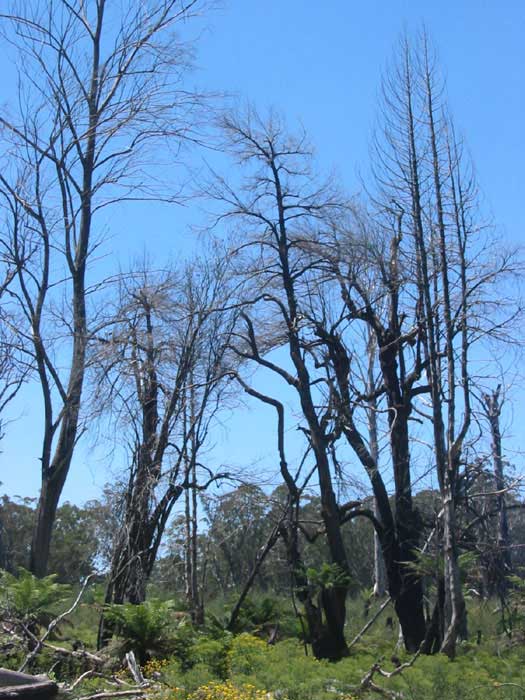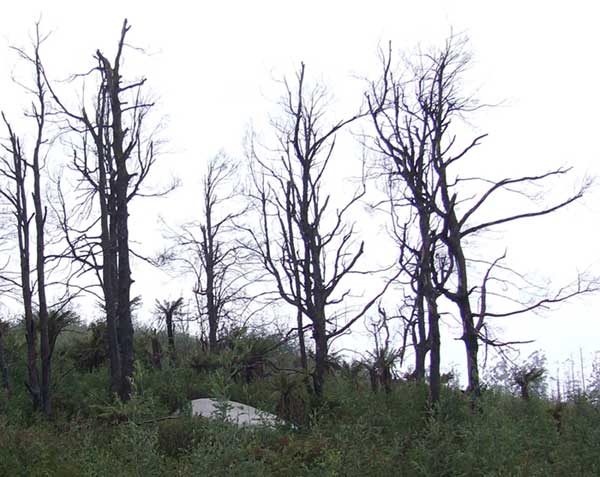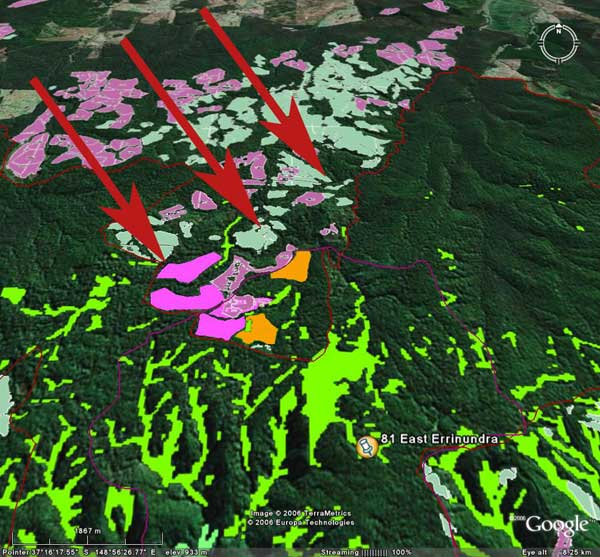Rainforest is fire sensitive
Australian eucalypt forest has evolved to cope with low and high intensity bushfires situations. Eucalyptus forest depend on fire for regeneration. However rainforest communities are much more likely to be destroyed by fire and replaced by a eucalypt forest.
Unlike eucalyptus forest, rainforests are plant communities that have not evolved to survive wildfires very well. This fact means rainforest now only exists in natural fire refuges such as hilly high-rainfall areas where the rainforest can grown in moist gullies on south facing slopes.
The following quotes from Cameron (1992) best describes this aspect.
"Rainforest is defined ecologically as fire-sensitive forest composed of or dominated by primary or secondary rainforest species. Fire-sensitive forest is defined as forest vegetation which is either uniquely adapted and restricted to relatively fireproof topographic niches, or which, once established, acquires an intrinsic capacity to resist destruction of canopy by running crown fire. The incursion of low intensity surface fire is recognised as a normal and recurrent phenomenon within at least some rainforest communities, particularly warn temperate rainforests in Victoria, and often contributes to the maintenance of a characteristic assemblage of secondary species and a rich herbaceous flora."
Cameron, D (1992), 'A portrait of Victoria's rainforests: distribution, diversity and definition.' In P Gell & D Mercer (eds.), Perspectives on Definition, Classification and Management." Monash Publications in Geography, Melbourne. pp. 13-96.
The sensitivity of rainforest communities to fire is the main reason these plant communities have been listed as threatened under the Flora and Fauna Guarantee Act. See More

Small rainforest stand was destroyed by fire as a part of a clearfell logging operation at East Errinundra RSOS 81 in 2001. This is an example of rainforest species not being fire tolerant.

Cool Temperate rainforest stand destroyed by fire as a part of a clearfell logging operation at Mt Baw Baw 2004.
Clearfell logging is making wet forests drier and more fire prone
Clearfell logging can considerably alter fire behaviour by replacing older, moist wet eucalypt forests that have lower levels of ground fuel, into dense regrowth forest that is drier and have higher levels of ground fuel. The higher fuel loads of young regenerating forest can elevate the intensity and rate of spread of catastrophic wildfire's burning towards core rainforest areas.
See more about why clearfell logging is making wet forests more fire prone (OREN website)
The lower stand height of young regenerating trees compared to the larger trees of mature forests, can also promote a very destructive crown fire within the rainforest. Very hot and fast spreading fires which burn directly into the rainforest canopy have the capacity to destroy fire-intolerant rainforests, replacing them with fire adapted eucalyptus forests. Recent observations based on aerial photography suggest that Cool Temperate Rainforest surrounded by substantial areas of mature forest is more likely to survive wildfire than rainforest surrounded by immature forests.
Wet or damp old growth eucalypt forests act like nature fire dampeners that can help reduce the intensity of wildfire.
Case study: Fire, Rainforest, logging & the Errinundra National Park
Wildfire does not stop at National Park boundaries. Clearfell logging around the edge of the Errinundra National Park is significantly increasing the risk of wildfire destroying rainforest within the National
Park.
The image below shows a scenario where intense wildfire is blown by a dry hot north west wind (shown by the red arrows) through clearfell logged areas that now contain dry fire-prone re-growing eucalypt forest ( shown as pink and green). The orange areas show future clearfell logging planned in wet old growth forest that will extend the logged out area closer to the north west edge of largest stand of Cool Temperate rainforest in Victoria (shown in bright green). Hence future planned logging is increasing the risk these nationally significant rainforest stands within the national park get destroyed by wildfire.
A large buffer needs to be established to protect the Errinundra National Park rainforests from wildfires. This is particularly the case as the regrowth after clearfell logging can make wildfires more intense.

The red arrows show the direction of a north westerly driven fire through dry clearfell logged areas (shown in pink and green). The Orange areas are planned future clearfell logging that will further increase the risk of catastrophic wildfire reaching the extensive stands of Cool Temperate Rainforest (bright green) within the Errinundra National Park (Red line). Note the purple line is East Errinundra RSOS 81.